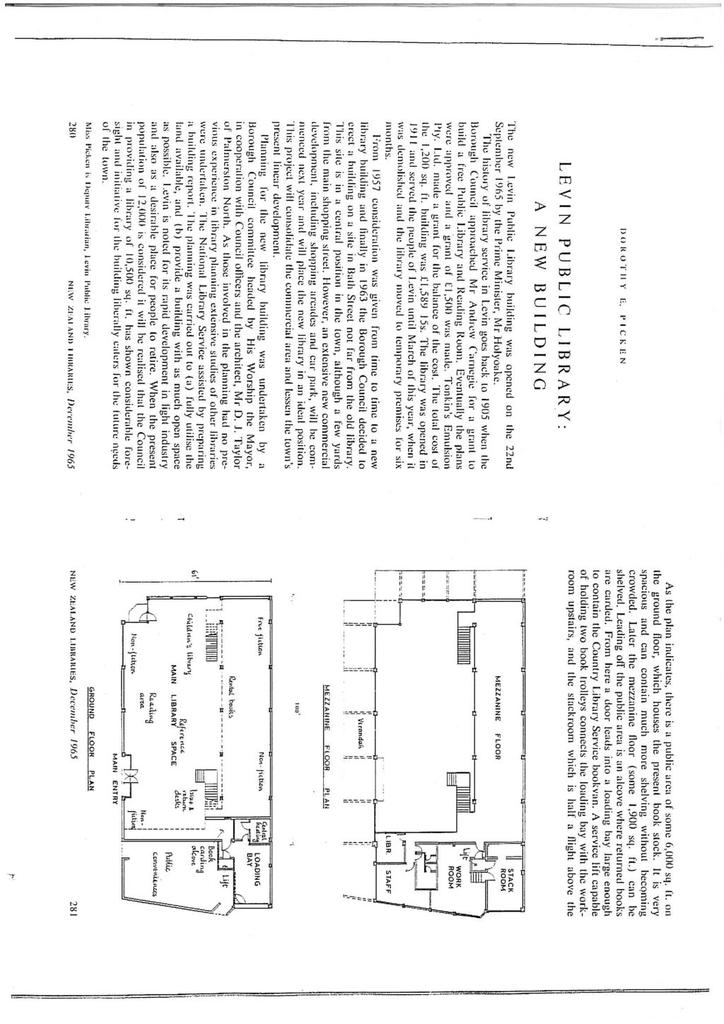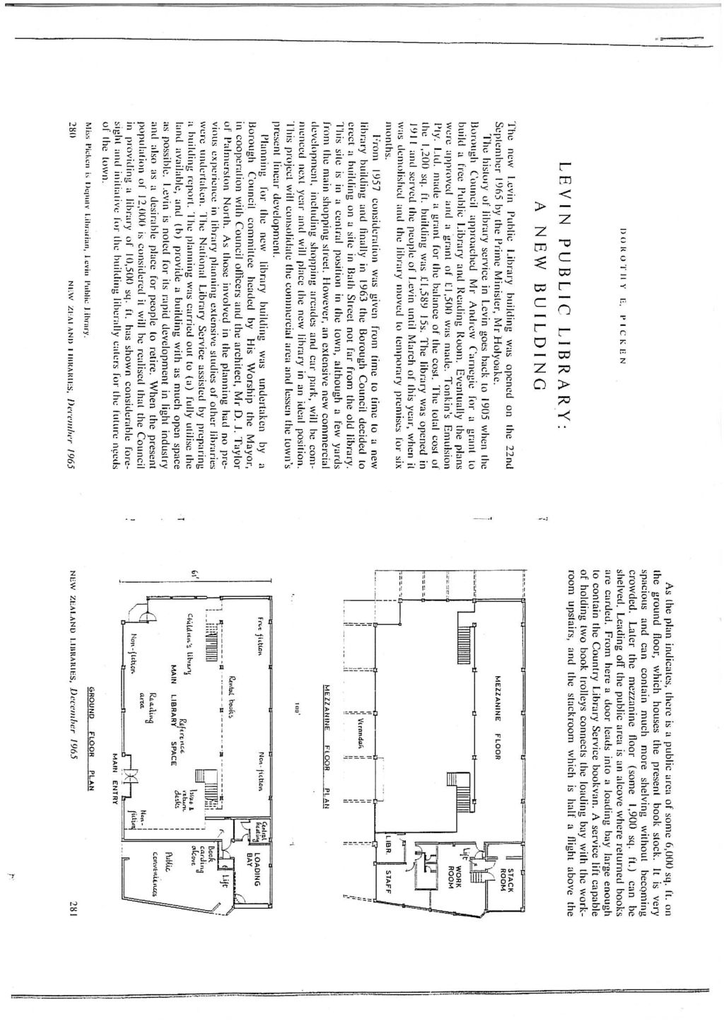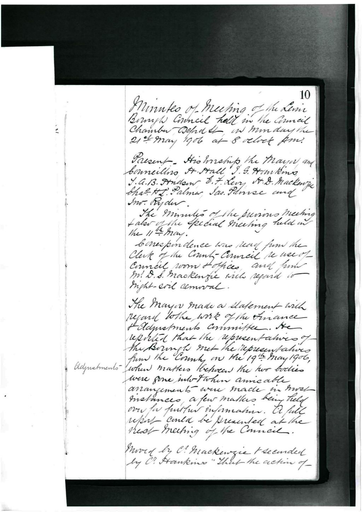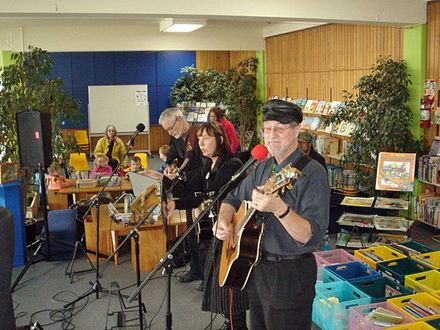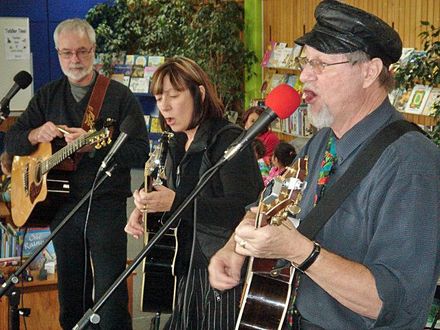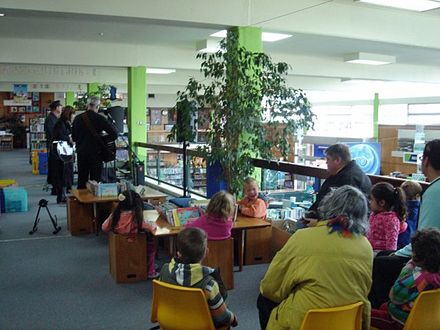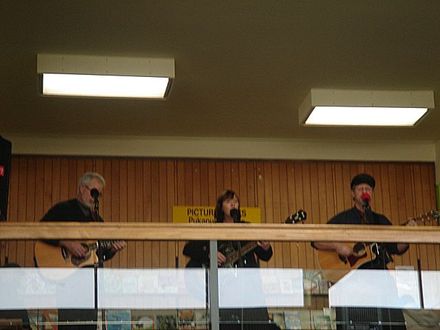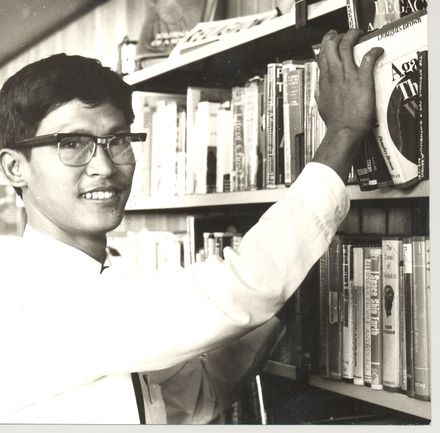Levin Public Library : a new building
- Description
LEVIN PUBLIC LIBRARY: A NEW BUILDING
The new Levin Public Library building was opened on the 22nd September 1965 by the Prime Minister, Mr Holyoake.
The history of library service in Levin goes back to 1905 when the Borough Council approached Mr Andrew Carnegie for a grant to build a free Public Library and Reading Room. Eventually the plans were approved and a grant of £1,500 was made. Tonkin's Emulsion Pty. Ltd. made a grant for the balance of the cost. The total cost of the 1,200) sq. ft. building was £1,589 15s. The library was opened in 1911 and served the people of Levin until March of this year, when it was demolished and the library moved to temporary premises for six months.
From 1957 consideration was given from time to time to a new library building and finally in 1963 the Borough Council decided to erect a building on a site in Bath Street not far from the old library. This site is in a central position in the town, although a few yards from the main shopping street. However, an extensive new commercial development, including shopping arcades and car park, will be commenced next year and will place the new library in an ideal position. This project will consolidate the commercial area and lessen the town's present linear development.
Planning for the new library building was undertaken by a Borough Council committee headed by His Worship the Mayor, in cooperation with Council officers and the architect, Mr D. J. Taylor of Palmerston North. As those involved in the planning had no previous experience in library planning extensive studies of other libraries were undertaken. The National Library Service assisted by preparing a building report. The planning was carried out to (a) fully utilise the land available, and (b) provide a building with as much open space as possible. Levin is noted for its rapid development in light industry and also as a desirable place for people to retire. When the present population of 12,000 is considered it will be realised that the Council in providing a library of 10,500 sq. ft, has shown considerable foresight and initiative for the building liberally caters for the future needs of the town.
As the plan indicates, there is a public area of some 6,000 sq. ft. on the ground floor, which houses the present book stock. It is very spacious and can contain much more shelving without becoming crowded. Later the mezzanine floor (some 1,900 sq. ft.) can be shelved. Leading off the public area is an alcove where returned books are carded. From here a door leads into a loading bay large enough to contain the Country Library Service bookvan. A service lift capable of holding two book trolleys connects the loading bay with the workroom upstairs, and the stackroom which is half a flight above the workroom and directly above the loading bay. In keeping with the rest of the building the workroom is spacious and well appointed with linoleum covered benches and a stainless steel sink. A five-foot gallery leads past the workroom to the librarian's office and staff quarters. A panoramic view of the library is obtained from the interior windows of the workroom and librarian's office.
The walls are of reinforced concrete blocks, faced outside with bricks and lined inside with honey coloured tawa board panels. A special feature of these tawa panels is the incorporation of narrow battens screwed into the wall every three feet. When it comes to shelving the walls the battens are removed to the length required and the shelving channels are actually set in the wall. Steelcase shelving was transferred from the old library and used along most of the rear wall. As the other shelving (apart from that in the stackroom) is Alex Harvey Futura shelving, it was considered that the blending of the two different kinds of shelving might look rather odd but actually it is not at all obvious now there are hooks on them.
A Riccarton carpet covers the floors and staircases, apart from the stackroom and workroom, and has caused much favourable comment and interest. The colouring of the carpel forms an integral part of the subtle and pleasing colour scheme. It is woven in varying tones of cool greens, blue and turquoise warmed by touches of orange. Adding to this warmth is the effect of the wooden walling and the natural wood of the desks and tables. The pillars are painted deep grey, elsewhere a paler grey is used. The Domo chairs are either grey or orange-red. Particularly attractive is the mahogany handrail that extends right around the mezzanine floor and on either side of the stairways. Armour plate glass sections complete the railing.
Central heating is provided downstairs by pipes conducting hot water which are embedded in the concrete floor, on the mezzanine floor by hot air vents and in the work and staff rooms by panel wall heaters. This heating is powered by a gas fired furnace. In hot weather when a certain temperature is reached blowers automatically switch on to circulate the air.
On the outside wall beside the main entrance is a piece of sculpture, the work of T. V. Johnston of Palmerston North. It is cast in cold metal and depicts an ancient story teller sitting with a lyre. A man, woman and child are grouped beside him and listen to his tale.
Most of the ground floor can be seen from just inside the main entrance. Low, free standing shelving immediately to the left features displays of books. Adjacent to it is the information desk with the quick reference collection close by. Near the stairs and to the right of the entrance arc the issue and returns desks, behind them the book carding alcove. At present the shelving on the wall at this end contains the non-fiction hooks in the Dewey 100 to 600 classes. Under the mezzanine floor travel, history, biography, literature and free fiction books arc shelved, and here also is the rental collection. Turning sharply left from the entrance there is a reading area with chairs and tables and nearby shelving for magazines and a stand for newspapers. At the far end of this reading area is high, free standing shelving one side of which is used for art books (which make an attractive display for passersby to see through the large corner window) and other books in the Dewey 700 class. Easy chairs are grouped here for casual reading. The children's library is at this end of the building and furthest from the main entrance. There is another entrance leading into the children's library but this is not used at present.
Several pieces of furniture were specially designed by Mrs Anne Johnston of Palmerston North. The returns desk has three slots in the top through which borrowers post their books into three spring-loaded bins beneath. As these fill they are wheeled out to the carding alcove and replaced by other empty bins. The issue and information desks match the returns desk in design. Two children's picture book tables each consist of a square divided into four tubs with a flat surround that acts as a hook rest. These stands are very popular after school when the younger children crowd around and sit on the three-sided wooden chairs to browse happily through the books.
When the library opened the Levin Art Society staged a display of eighty paintings on the mezzanine floor. As well as fixtures for wall hanging the library has six specially constructed screens to cater for displays. The paintings attracted considerable interest. They have now been replaced by a photographic display featuring work of the Levin Camera Club and it is planned to continue similar displays. In addition, show cases are being built to house historical material.
When a library moves from a building of 1,200 sq. ft. to one of 10,500 sq. ft., the bookstock looks somewhat smaller. As well as an extra grant for the book fund this year, the stock has been boosted by generous loans from the Country Library Service. At the time of the opening the Service sent a very fine loan of books on art and architecture which found an immediate response from the local artists whose work was in the display on the mezzanine floor. Likewise a loan collection of photography books has tied in with the Camera Club's display. Extra children's books came from the School Library Service and they just vanished as the children came in droves to the new library.
The justification for a large and beautiful library such as ours lies in the use made of it. It is gratifying to observe the public response, and to notice how people react to the inviting atmosphere by leisurely browsing and sitting and reading. More books are taken home too, the issue figures suddenly rose by one-third and now after six weeks this increase is being maintained.
BUILDING DATA
NAME OF LIBRARY: Levin Public Library.
DATE OPENED: 22nd September 1965.
POPULATION SERVED: 12,000
ARCHITECT: D. J. Taylor, Palmerston North.
CONSULTANTS: National Library Service (library planning); G. Vamos and partners, Wellington (heating).
CONTRACTOR: J. W. Lancaster,. Levin.
AREA OF BUILDING: public area: 7,938 sq. ft.; work, stack and staff area: 1,962 sq. ft.; loading bay: 432 sq. ft.; central healing main: 238 sq. ft.; total library area: 10,570 sq. ft.
SHELVING: Futura steel, adjustable, Alex Harvey Ltd.; amount in public area: 1,451 linear ft.; in stack and work area: 240 linear ft.; total: 1,691 linear ft_
SEATING; upright chairs: Dome), Steel Web Upholstery Ltd.; lounge chairs: Cintique, A. W. Allen Ltd., Levin; total sealing; 38 seats.
OCHER RN ITU RE: issue, return and information desks; Anne Johnston special design, Walkley and Norton Ltd., Levin; children's picture book tables and chairs: Anne Johnston special design.
SCULPTURE: T. V. Johnston. Palmerston North.
LIGHTING : Fluorescent.
FLOORING: Carpet, Felt and Textiles Ltd.
HEATING: Central heating—gas tired furnace, floor heating downstairs, hot air vents mezzanine floor, panel heaters elsewhere, A. and T. Burr Ltd.
COSTS: building, including shelving: £55,648; furnishings and fittings: £12,000; total cost of building: £56,848; cost per sq. ft.: £5. 4s. 4d.
Miss Picken is Deputy Librarian, Levin Public Library.
NEW ZEALAND LIBRARIES, December 1965, Pages 280-285
Identification
- Date
- December 1965
Taxonomy
- Community Tags

